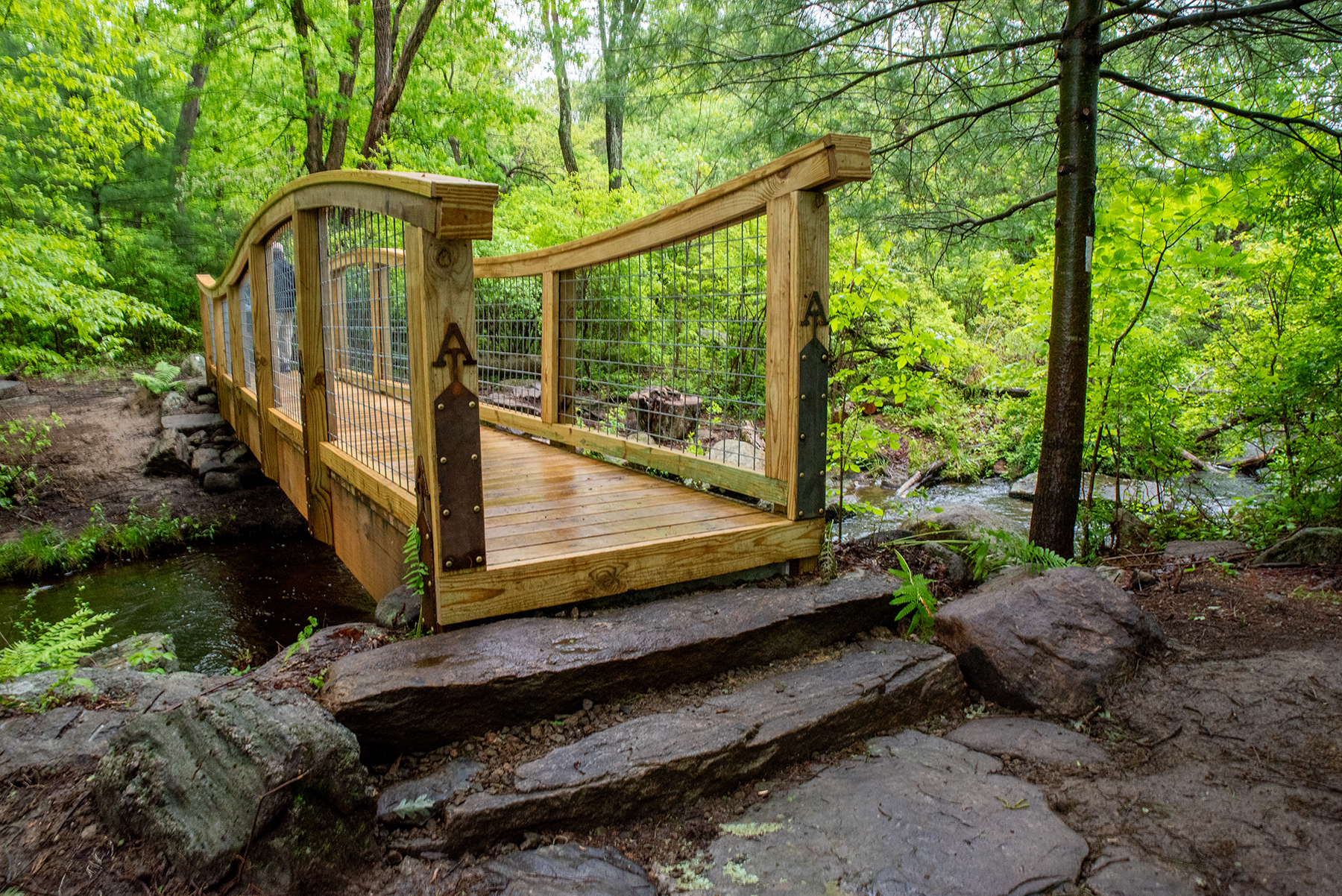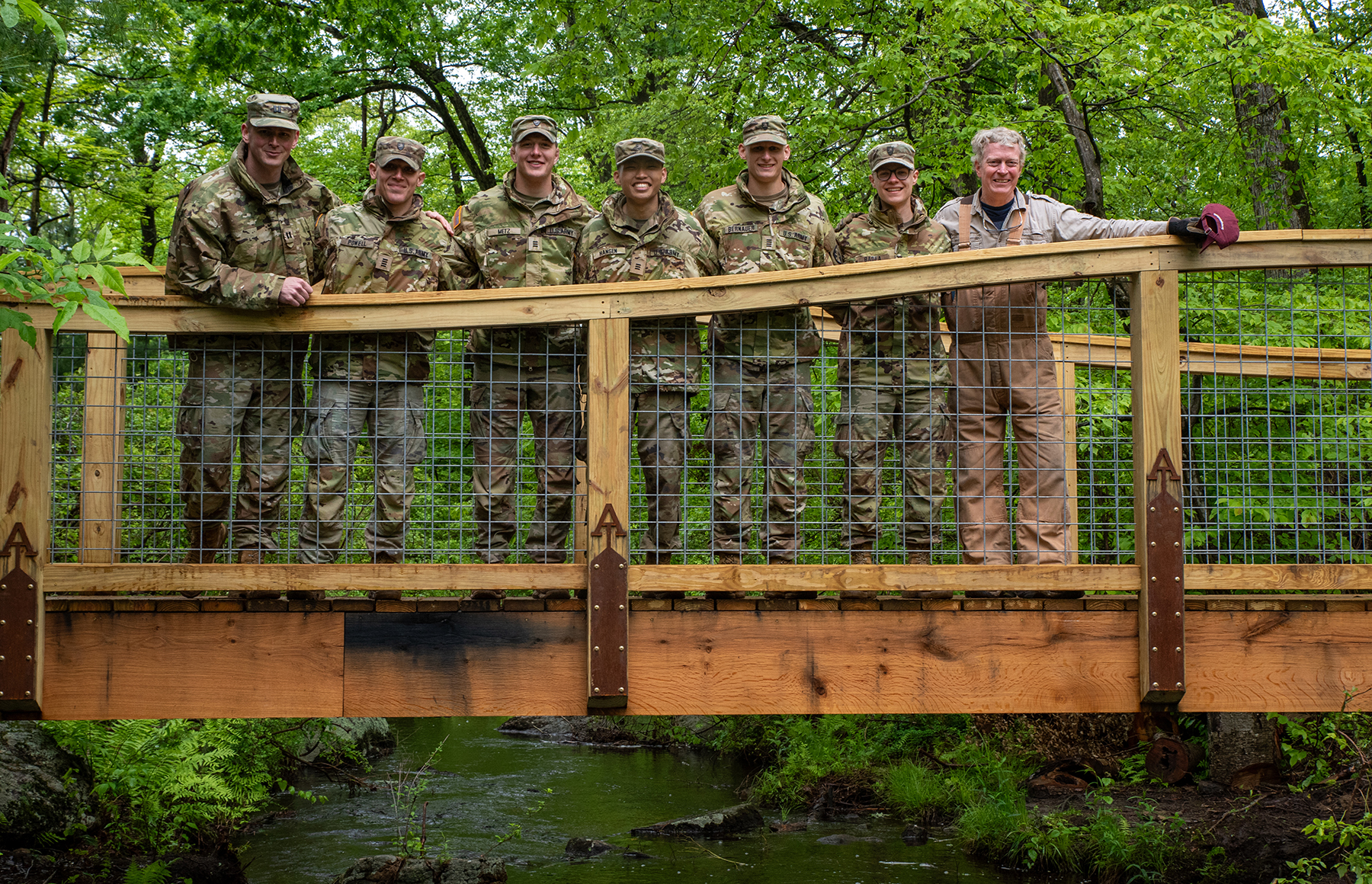 Bill Amos, courtesy of the Open Space Institute
Bill Amos, courtesy of the Open Space InstituteOver eight years ago, the Open Space Institute heard that the U.S. Military Academy cadets had just completed a bridge on Bannerman’s Island in the Hudson River, about 50 miles north of New York City.
OSI, a national land conservation organization, looks to increase access to natural spaces. Part of realizing this mission is to build bridges over crossings deep in forested areas. When OSI heard about the cadets’ work, it saw an opportunity for a partnership. After all, here was a chance to marry engineering cadets’ specialty expertise with OSI’s needs to make natural spaces more accessible.
Further reading:
- Buffalo community comes together to shape, celebrate pedestrian bridge
- Dallas-area cyclists, pedestrians celebrate unique bridge over highway
- First-ever pedestrian bridge inspection process proposed
The West Point-OSI partnership launched more than eight years ago and has produced nine trail bridges. Designing and building the bridge is a capstone project for civil engineering students who participate.
Criteria for project selection
While the 2025 project was pedestrian-only, some previous bridges have been designed for light trucks and emergency response vehicles.
OSI works with regional partners who might have bridge construction needs of their own. Over the 2025-26 school year, for example, cadets will work on a project for Orange County, New York, connecting an “active” side of a park, which includes ball fields and playgrounds, with the “passive” side, which includes nature trails and wildlife observation opportunities.
Among the many criteria for project selection: a significant design component.
“We’ve got to have an opportunity for the cadets to exercise their skills in multiple civil engineering specialties,” said Ledlie “Led” Klosky, Ph.D., P.E., M.ASCE, a faculty adviser for the projects. Klosky is a professor of civil engineering and the Dean’s Executive Agent for Design and Construction at West Point. Geotechnical and structural engineering play roles, as do hydrology and hydraulic design in crossing waterways, Klosky said.
Another qualifying factor in project selection is distance from West Point.
“The cadets only have so much time, and they need a lot of permissions to leave the base,” explained Peter Karis, vice president for parks and stewardship at OSI. The Orange County park is about 26 miles from West Point.
The scale of the project is also an important consideration, Karis said.
“We have found that a 10- to a 30-foot bridge is the sweet spot for something that can be handled in a project term,” he added. “Cadets have to work within the constraints of logistics and budget and have to deal with the client group and decision-makers.
“They present concepts and get feedback, and a decision is made. The cadets have to take that decision and run with it, all steps that are very emblematic of what they’ll have to do when deployed in the Army.”
OSI acts as a convener, bringing the cadets together with donors who fund the projects. No federal monies are used.
The Appalachian Trail bridge project
The cadets’ most recent project involved constructing a pedestrian trail bridge along the Appalachian Trail at Harriman State Park in New York. Five civil engineering cadets, with support from three faculty advisers, designed and constructed the 34-foot-long steel bridge.
Being nestled in the woods presented challenges, Klosky said. The bridge’s load-carrying component is steel framing, with the main girders a little over 800 pounds apiece.
“It was not practical to put 800 pounds on your shoulder and bring it to the woods,” Klosky said. “It gets too logistically challenging and too dangerous to try by hand.”
As a safer solution, each girder was fabricated and delivered to the site in three pieces of roughly 250 pounds each. Once on-site, the gusset plates were attached and the girders were flown into place using a highline the cadets rigged.
The highline was used to hoist the end of the girder that was over the stream. It was impractical to manually carry the full beam because the stream is too deep and wide.
“During placement, the end of the beam on dry ground was handled manually, while the end over the stream was suspended from a trolley system that ran along a highline,” Klosky said. “So, while still heavy, only one half of the total girder weight was being handled manually, while the other half was suspended from the highline.”
 Bill Amos, courtesy of the Open Space Institute
Bill Amos, courtesy of the Open Space Institute“There’s a long military tradition of taking heavy loads across water crossings,” he added. “Since the earliest military operations, engineers have been called on to bridge waterway gaps and get materials moving, so this was a very military-style operation.”
Erasing the misconception about the military’s lack of creativity, the bridge has asymmetrical curvature along the railing, architectural elements that the cadets designed to reflect the natural setting, Klosky said. To complete the aesthetics, the cadets covered the bridge’s exterior beams in an oak facade with native oak cut from the forest’s own sawmill.
The visual aspect of the project needed approval from many stakeholders, which was a good lesson in learning communication skills by sharing the “whys and the hows and exactly what the bridge was going to look like,” Klosky said. The bridge also had to meet code requirements to ensure safety. The cadets produced over 100 pages of calculations that went through three layers of review: a local professional engineer, West Point faculty, and park officials.
The project was also physically challenging in many ways. The cadets hand-excavated the foundations on the two banks and hauled and cast the concrete.
“They were out there with picks and shovels and tunneling bars,” Klosky said. “In the glaciated setting, we had to move a lot of big rocks.”
A volunteer group of stone masons, the Jolly Rovers, quarried stones from around the site and used them for the approach steps as well as around the concrete foundation to armor it against stream bank erosion.
The partnership has been rewarding for OSI and the cadets. “These annual bridges are one of the highlights of our parks program at OSI,” Karis said. “It’s so rewarding to work with the young people and give them an opportunity to get a strong foundation to advance their careers.”
“You get to the point where you can’t wait to get out in the field, put on some coveralls, and drive a few nails with the cadets,” Klosky said. “The cadets learn so much more than civil engineering on these projects. They’re learning about people, about themselves. It’s really growing a young person into a better individual and a better engineer.”



